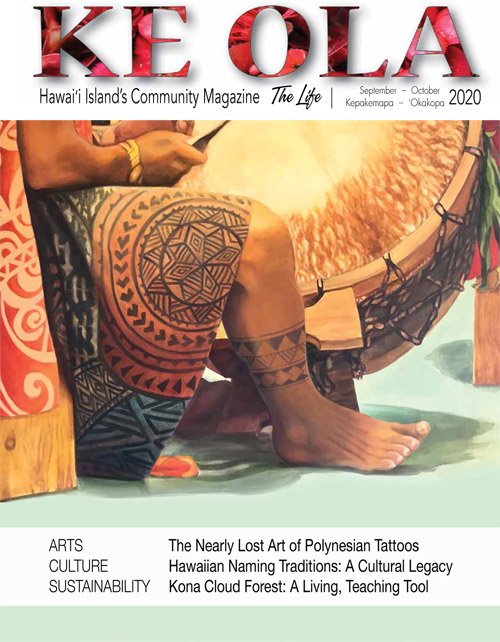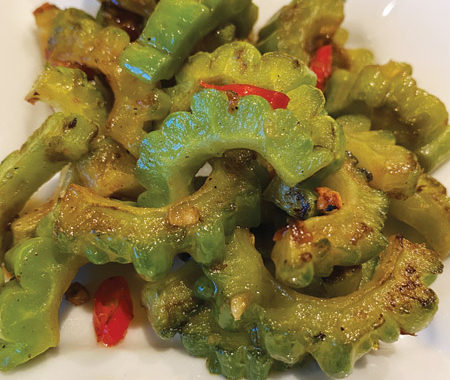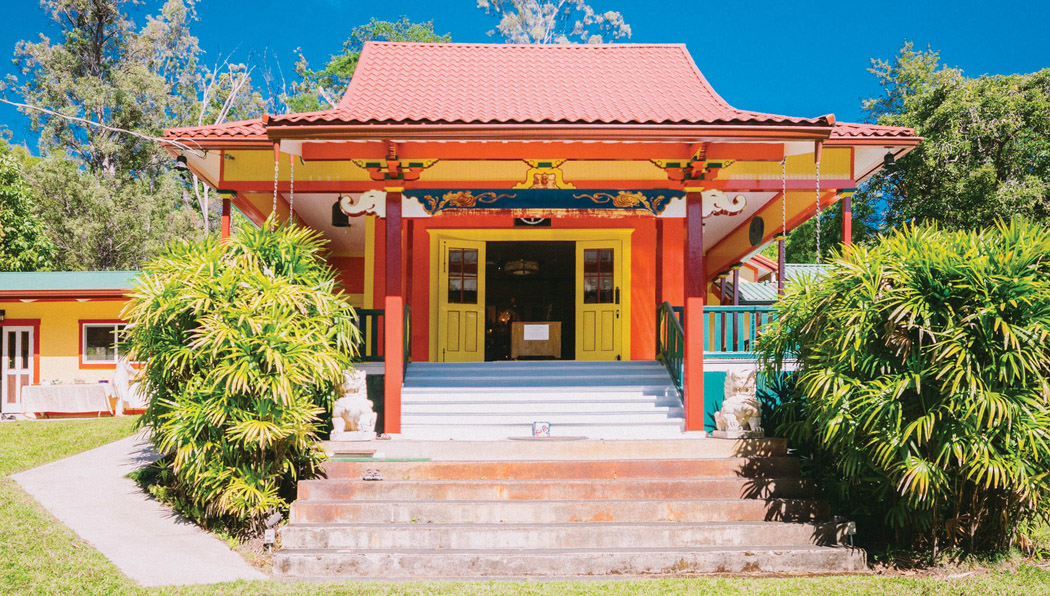
Wood Valley Temple and Its Fascinating Historical Journey

By Karen Valentine
Those who wonder how a small, yet world-renowned, Buddhist temple ended up in a remote valley not far from an active volcano, may realize that a scholarly account isn’t adequate to tell the story. There must be some sense of spiritual destiny, as evidenced by two momentous visits by His Holiness the 14th Dalai Lama of Tibet, and a successful search for a reincarnated lama.
The architecturally distinct and quaint building is so venerable, it was disassembled, moved, and reassembled before settling in its lush, verdant, fern-adorned site where prayer flags flutter in the breeze and peacocks have been known to wander. Quiet and peaceful, Wood Valley Temple—or Nechung Dorje Drayang Ling in Tibetan—located mauka (upland) of Pāhala in Ka‘ū, awaits the seeker to come, sit, and contemplate.
The story, which began in 1902, also involves the journey of the temple directors to find the reincarnation of the founding Tibetan lama, Nechung Rinpoche, plus a humorous incident involving a Japanese Buddhist priest and his friend holding vigil during a historic flood back in 1917.
The vibrantly colorful façade of today’s Wood Valley Temple is more typical of its current Tibetan occupants than the more conservative style of its former Japanese Buddhist stewards, says temple Director Marya Schwabe, who with her husband, Michael, have directed temple programs for 45 years. Many volunteers have come and gone since the temple’s inception in 1973, while Michael and Marya have remained a constant presense up to the present day.
“We’ve had over 50 lamas here, with some incredible teachings,” says Marya, who served as the translator for many of them. The couple has organized momentous visits by His Holiness the 14th Dalai Lama on two separate occasions. “We spent a year in India when Rinpoche passed away, and went there annually to attend the teachings of His Holiness.”
They feel fortunate to have learned from the great masters, Marya reflects, and they have integrated the essence of Tibetan Buddhist principles into their lives and work. She leads regular prayer services while Michael has managed the maintenance and periodic expansion of the temple buildings and grounds.
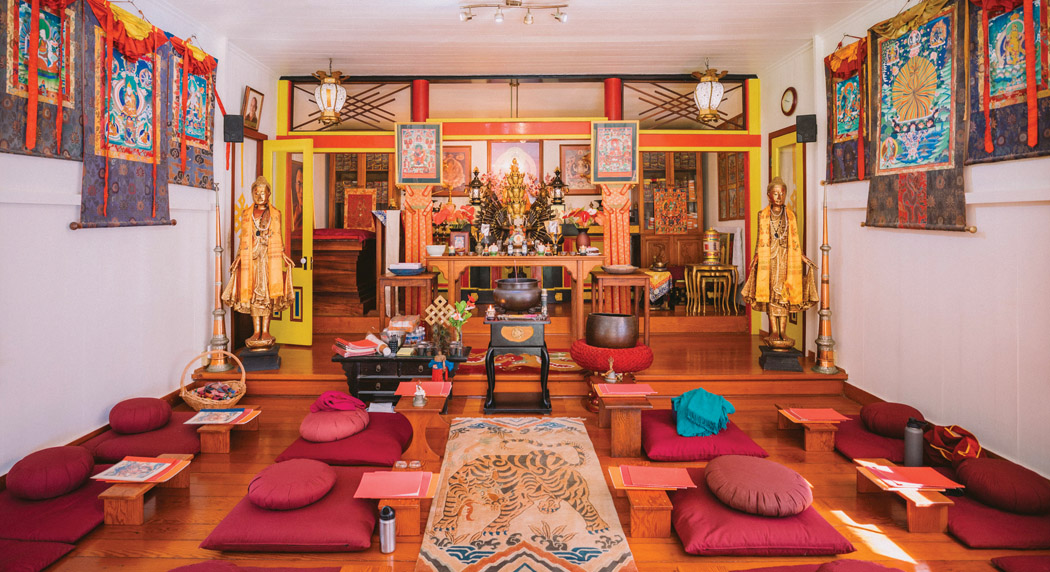
Early Days
Originally built in 1902 to support the Japanese immigrants working in the Ka‘ū sugar industry with Nichiren Buddhist teachings, the temple was first located in what was called “Church Camp,” about halfway between Wood Valley and the town of Pāhala.
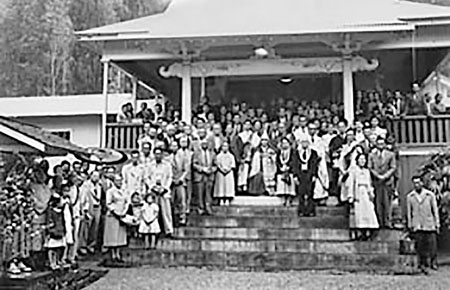
The temple itself may have stayed where it was originally built were it not for a major flood in 1917 which made it clear that a site on higher ground was more sustainable. The story goes, as the waters were quickly rising, the temple priest and a friend bravely stayed to guard the building. As night fell, they were completely cut off from dry land. A precious store of sake was inside, purchased for a New Year’s celebration. The rest you can guess. The pair decided that if they were going to die, they should at least die happy, and so proceeded to drink their way through the sake supply. As dawn revealed the temple still standing—with extensive structural damage—it also revealed the priest and his friend prostrate with happiness!
Volunteers went to work disassembling and moving the building to its present location, where it was rebuilt in 1925 at the center of a busy village located between the two worker camps of Wood Valley and Kapāpala. Later on, in the mid-1960s, Ka‘u Sugar closed down the two camps and villagers moved to Pāhala, with some of the houses moving there as well. (In those days, it was more common to reuse building materials rather than purchase new ones.) The temple was abandoned.
The Tibetans Arrive
In 1972, a Tibetan Buddhist lama visited the islands, giving a teaching in Honolulu. Despite Hawai‘iʻs large Buddhist population, it had not become a destination for Tibetans, due to their refugee status in exile from their home country. In the 70s, Westerners were becoming interested in Buddhist and Hindu teachings. Among them was a young couple who journeyed from Hawai‘i to India. There they visited Nechung Monastery, inhabited by refugee Tibetans in Dharamsala, India. They were so touched by the warmth and friendliness of the Tibetans and their teachings that they were inspired to invite a high lama, Nechung Rinpoche, to start a center for Buddhist study and meditation in Hawai‘i. He agreed to come and a nonprofit organization was formed to sponsor him. A statewide search assisted by University of Hawai‘i Professor William Bonk led the group to the abandoned temple in Wood Valley. They received a lease and the restoration on the temple buildings began in November 1973.
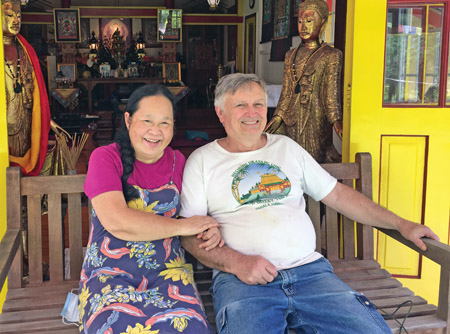
Michael and Marya Schwabe came to Wood Valley Temple in 1974 for a weekend retreat with a visiting lama. They had an interest in yoga and eastern philosophy, but had no specific Buddhist training. Upon hearing that Nechung Rinpoche would arrive the following year, they decided to stay and help prepare for his arrival with the intention to study with him. They ended up living there with Rinpoche from 1975 until his passing in 1983, studying Buddhism and learning spoken and written Tibetan.
While they direct the temple affairs, Marya and Michael network with Nechung Monastery in India, plus other Buddhist monasteries and centers, inviting lamas to come and teach.
Occasionally a monk (as opposed to a lama) will also stay at the temple. “Our most recent monk, Tiapala, who lived here for 30 years, passed away last year. He was the assistant to the previous Rinpoche. Since he left, we haven’t had a full-time resident monk.”
The temple has a regular schedule of Sunday services and observations of special days. “People come from the Hilo area and as far as Ocean View to attend our more regular practices and Sunday service. When we have high lamas, more come from the other islands and the mainland. When the founding Rinpoche was here, he taught weekly classes to a small group of students.”
Preparing for the Dalai Lama
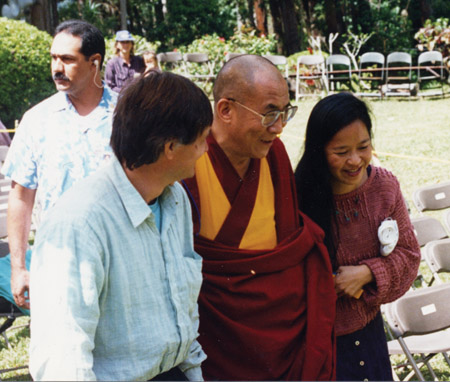
“His Holiness the Dalai Lama came twice,” says Marya, “and he actually stayed here, which is quite unusual. It’s also because Nechung is very connected to the succession of Dalai Lamas.”
When his first visit in 1980 was planned, it was by invitation and several hundred attended. At that time, he spoke and dedicated the new temple: Nechung Dorje Drayang Ling.
“It had taken six months to plan and prepare. We tore down several plantation houses and built the downstairs of the retreat building. The upstairs was added by moving another Japanese temple from lower Pāhala. I had to work with the state, county, and federal officials to coordinate the visit, because His Holiness is treated like a head of state.”
The second visit of His Holiness the Dalai Lama to Wood Valley in 1994 became one of the most historic events to take place in the Ka‘ū District. More than 3,500 people came from all over to listen to his afternoon talk given on the temple veranda. You can now read his remarks on the Wood Valley Temple website.
The attraction of Wood Valley Temple for visiting lamas, including those from other traditions, is obviously not due to a large audience. Some lamas have stayed five weeks at a time, Marya said. “We are this little place nestled in the middle of the forest, in the middle of the Pacific, that is very conducive to their teaching. It’s like a pure land or a paradise in Buddhist teachings. It’s so peaceful, and the air is fresh. His Holiness remarked on how he felt like he ‘was coming homeʻ when driving up the road to the temple.”
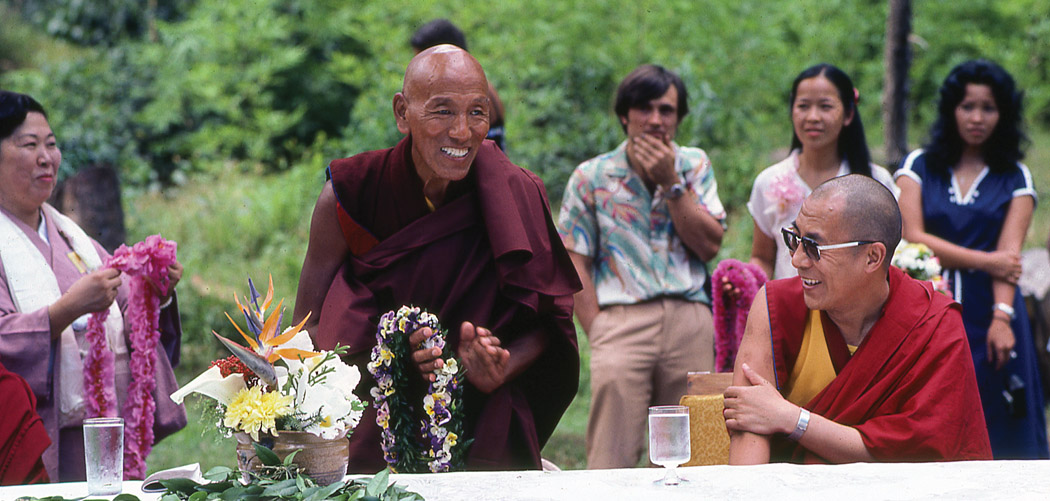
Searching for the Reincarnation of Nechung Rinpoche
After death comes for a Rinpoche—a Tibetan Buddhist spiritual master considered to be imbued with mystical powers—it is believed he or she may choose to reincarnate.
Marya and Michael traveled to the Chinese-occupied Tibet after the death of the temple founder, Nechung Rinpoche, in a tedious and somewhat treacherous journey to find his reincarnation, assisted by His Holiness the Dalai Lama and the Nechung Oracle, who formally recognized a boy born in Lhasa, Tibet, as his reincarnation. Marya is in the process of soon publishing her book, Road to Freedom: A Journey from Occupied Tibet, The True Story of the Search, Discovery and Escape of a Reincarnate Lama, a memoir of this search.
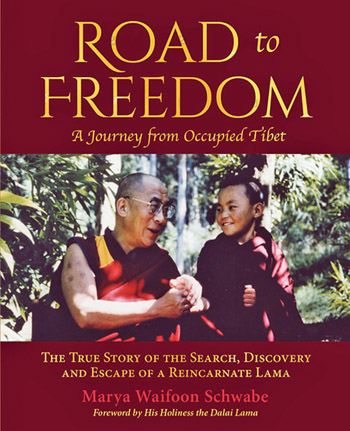
Excerpted from the book’s cover:
“His Holiness gave several clues: the year of the boyʻs birth, names of his parents and the locale of Lhasa, the capital city of Tibet. A search party of three people—a monk from Nechung Monastery in India, Michael and Marya—made journeys to Tibet in 1987 and 1993 for the discovery. Their search led them to sacred visionary lakes and ancient monasteries. Tibet is a Chinese communist-occupied country where surveillance abounds and any deviation from the rule-of-law is not tolerated. The expedition was precarious and filled with challenges—such as where to look, whom to trust and how to accomplish a nearly impossible mission. Ultimately, the escape entailed crossing 18 checkpoints (many guarded by armed soldiers) including two international airports, with the eight-year old lama.”
The lama they found, Nechung Choktrul Rinpoche, is now 35 and continues to visit Wood Valley even while undergoing his studies to become a monk. “He’s been here 10 times,” Marya says. “Due to the comprehensive education in India for monks, he studied there after leaving Tibet and went to college for 10 years. He’s now head of the Nechung monastery.”
Since the coming of age of the new Rinpoche, Michael and Marya have worked closely with him to manage his yearly visits and teachings at the temple with the expectation that this will be his second home.
Currently they are leading plans to enhance the temple grounds with retreat and guest cottages as well as initiating an endowment fund to support the temple and continue its activities into the future. ❖
For more information: nechung.org
Mahalo Coldwell Banker Island Properties—Home/Building Story Sponsor
